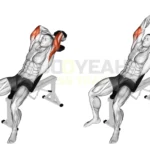The seated barbell military press is a key exercise for developing shoulder strength and muscle mass. As a vertical pressing movement, it targets the deltoids, triceps, and upper chest while engaging the core for stability.
Seated Barbell Military Press Overview
Incorporating vertical presses like the seated military press into your routine is essential for building upper-body strength and functional movement patterns. Experiment with different press variations to find the one that suits your body mechanics and goals. This exercise is versatile and can be included in shoulder-focused workouts, push sessions, upper-body routines, or full-body programs
Seated Barbell Military Press Instructions
- Set up an adjustable bench in an upright position under a barbell rack. Adjust the barbell height to just below your shoulders when seated.
- Load the barbell with an appropriate weight for your strength level.
- Sit on the bench, feet flat on the floor, and grip the barbell with a pronated (overhand) grip, hands slightly wider than shoulder-width.
- Unrack the barbell and hold it at shoulder level, keeping your core engaged and chest up.
- Inhale, brace your core, and tuck your chin slightly to maintain a neutral neck position.
- Lower the barbell slowly to just above your upper chest, keeping elbows slightly forward.
- Exhale and press the barbell upward until your arms are fully extended, avoiding locking your elbows.
- Repeat for the desired number of repetitions (e.g., 3 sets of 8-12 reps).
Seated Barbell Military Press Tips
Sit on a bench with back support, holding a barbell at shoulder height, palms forward. Press the bar overhead until arms are fully extended, avoiding locking elbows. Lower slowly to shoulder level, keeping elbows slightly forward. Engage your core and keep your back straight. Aim for 3 sets of 8-12 reps. Benefits include stronger shoulders and upper arms.
- At the top of the press, focus on extending upward without shrugging your shoulders excessively.
- Keep your elbows tucked close to your torso at the bottom of the movement, allowing them to flare slightly outward at the top for natural motion.
- Maintain wrist alignment by imagining you’re pushing your knuckles upward to prevent strain.
- Engage your core throughout to avoid arching your lower back, which can lead to discomfort.
- Keep your head positioned as if looking forward through a window, aligning your ears with your shoulders.
- If you experience shoulder discomfort, try a wider grip or explore alternative pressing movements (e.g., dumbbell presses or machine presses).
- Start with a lighter weight to master form before progressing to heavier loads.
Building shoulder strength with military presses? Learn how they enhance deltoids in our Ultimate Guide to Muscle Groups.






